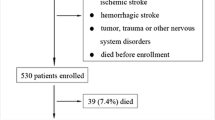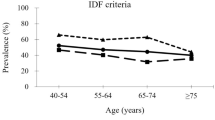Abstract
A silent brain infarction (SBI) can predict clinical overt stroke or dementia. Studies focusing on the elderly population, where SBI is most common, are sparse. We examined the associations between SBI and metabolic syndrome (MetS) in healthy elderly individuals. Neurologically healthy subjects (1,254 persons, 723 males) aged ≥65 years who underwent brain MRI were evaluated. MetS was diagnosed following the AHA/NHLBI-2005 criteria. We examined associations between full syndrome (at least three of the five conditions) as well as its components and SBI while controlling for possible confounders. One hundred and ninety-seven subjects (15.7%) were found to have one or more SBIs on MRI. Age (1-year difference) was found to be significantly related to SBI prevalence (OR 1.09; 95% CI 1.05–1.12). MetS was significantly associated with SBI (OR 1.68; 95% CI 1.15–2.44). The component model of MetS showed a strong significance between elevated blood pressure (OR 1.89; 95% CI 1.23–2.91) and SBI. Subjects exhibiting more components of MetS showed more prevalent SBI and multiple SBIs. MetS was found to be significantly associated with SBI in neurologically healthy elderly people. The positive trend between the number of MetS components and SBI could be used as a diagnostic tool to predict and prevent future stroke.


Similar content being viewed by others
References
Alberti KG, Zimmet PZ (1998) Definition, diagnosis and classification of diabetes mellitus and its complications. Part 1: diagnosis and classification of diabetes mellitus provisional report of a WHO consultation. Diabet Med 15:539–553. doi:10.1002/(SICI)1096-9136(199807)15:7<539::AID-DIA668>3.0.CO;2-S
Bokura H, Kobayashi S, Yamaguchi S (1998) Distinguishing silent lacunar infarction from enlarged Virchow-Robin spaces: a magnetic resonance imaging and pathological study. J Neurol 245:116–122. doi:10.1007/s004150050189
Bokura H, Yamaguchi S, Iijima K, Nagai A, Oguro H (2008) Metabolic syndrome is associated with silent ischemic brain lesions. Stroke 39:1607–1609. doi:10.1161/STROKEAHA.107.508630
Bonora E, Targher G, Formentini G, Calcaterra F, Lombardi S, Marini F, Zenari L, Saggiani F, Poli M, Perbellini S, Raffaelli A, Gemma L, Santi L, Bonadonna RC, Muggeo M (2004) The metabolic syndrome is an independent predictor of cardiovascular disease in type 2 diabetic subjects. Prospective data from the Verona Diabetes Complications Study. Diabet Med 21:52–58. doi:10.1046/j.1464-5491.2003.01068.x
Caplan LR (1996) Diabetes and brain ischemia. Diabetes 45(Suppl 3):S95–S97
Carplan L (1994) Silent brain infarcts. Cerebrovasc Dis 4:32S–39S. doi:10.1159/000108559
Davis PH, Clarke WR, Bendixen BH, Adams HP Jr, Woolson RF, Culebras A (1996) Silent cerebral infarction in patients enrolled in the TOAST Study. Neurology 46:942–948
Deedwania P (1998) The deadly quartet revisited. Am J Med 105:1S–3S. doi:10.1016/S0002-9343(98)00204-6
Fagan TC, Deedwania PC (1998) The cardiovascular dysmetabolic syndrome. Am J Med 105:77S–82S. doi:10.1016/S0002-9343(98)00216-2
Fisher CM (1982) Lacunar strokes and infarcts: a review. Neurology 32:871–876
Groop L, Orho-Melander M (2001) The dysmetabolic syndrome. J Intern Med 250:105–120. doi:10.1046/j.1365-2796.2001.00864.x
Grundy SM, Cleeman JI, Daniels SR, Donato KA, Eckel RH, Franklin BA, Gordon DJ, Krauss RM, Savage PJ, Smith SC Jr, Spertus JA, Costa F (2005) Diagnosis and management of the metabolic syndrome: an American Heart Association/National Heart, Lung, and Blood Institute Scientific Statement. Circulation 112:2735–2752. doi:10.1161/CIRCULATIONAHA.105.169404
Hoshi T, Kitagawa K, Yamagami H, Furukado S, Hougaku H, Hori M (2005) Relations of serum high-sensitivity C-reactive protein and interleukin-6 levels with silent brain infarction. Stroke 36:768–772. doi:10.1161/01.STR.0000158915.28329.51
Howard G, Wagenknecht LE, Cai J, Cooper L, Kraut MA, Toole JF (1998) Cigarette smoking and other risk factors for silent cerebral infarction in the general population. Stroke 29:913–917
Kobayashi S, Okada K, Koide H, Bokura H, Yamaguchi S (1997) Subcortical silent brain infarction as a risk factor for clinical stroke. Stroke 28:1932–1939
Kwon HM, Kim BJ, Lee SH, Choi SH, Oh BH, Yoon BW (2006) Metabolic syndrome as an independent risk factor of silent brain infarction in healthy people. Stroke 37:466–470. doi:10.1161/01.STR.0000199081.17935.81
Lee SC, Park SJ, Ki HK, Gwon HC, Chung CS, Byun HS, Shin KJ, Shin MH, Lee WR (2000) Prevalence and risk factors of silent cerebral infarction in apparently normal adults. Hypertension 36:73–77
Longstreth WT Jr, Bernick C, Manolio TA, Bryan N, Jungreis CA, Price TR (1998) Lacunar infarcts defined by magnetic resonance imaging of 3660 elderly people: the Cardiovascular Health Study. Arch Neurol 55:1217–1225. doi:10.1001/archneur.55.9.1217
Matsui T, Arai H, Yuzuriha T, Yao H, Miura M, Hashimoto S, Higuchi S, Matsushita S, Morikawa M, Kato A, Sasaki H (2001) Elevated plasma homocysteine levels and risk of silent brain infarction in elderly people. Stroke 32:1116–1119
Miranda PJ, DeFronzo RA, Califf RM, Guyton JR (2005) Metabolic syndrome: definition, pathophysiology, and mechanisms. Am Heart J 149:33–45. doi:10.1016/j.ahj.2004.07.013
Park K, Yasuda N, Toyonaga S, Tsubosaki E, Nakabayashi H, Shimizu K (2008) Significant associations of metabolic syndrome and its components with silent lacunar infarction in middle aged subjects. J Neurol Neurosurg Psychiatry 79:719–721. doi:10.1136/jnnp.2007.134809
Price TR, Manolio TA, Kronmal RA, Kittner SJ, Yue NC, Robbins J, Anton-Culver H, O’Leary DH (1997) Silent brain infarction on magnetic resonance imaging and neurological abnormalities in community-dwelling older adults. The Cardiovascular Health Study. CHS Collaborative Research Group. Stroke 28:1158–1164
Reaven GM (1988) Banting lecture 1988. Role of insulin resistance in human disease. Diabetes 37:1595–1607. doi:10.2337/diabetes.37.12.1595
Shinkawa A, Ueda K, Kiyohara Y, Kato I, Sueishi K, Tsuneyoshi M, Fujishima M (1995) Silent cerebral infarction in a community-based autopsy series in Japan. The Hisayama Study. Stroke 26:380–385
Shintani S, Shiigai T, Arinami T (1998) Silent lacunar infarction on magnetic resonance imaging (MRI): risk factors. J Neurol Sci 160:82–86. doi:10.1016/S0022-510X(98)00182-8
Stamler J, Vaccaro O, Neaton JD, Wentworth D (1993) Diabetes, other risk factors, and 12-yr cardiovascular mortality for men screened in the Multiple Risk Factor Intervention Trial. Diabetes Care 16:434–444. doi:10.2337/diacare.16.2.434
Uehara T, Tabuchi M, Mori E (1999) Risk factors for silent cerebral infarcts in subcortical white matter and basal ganglia. Stroke 30:378–382
Vermeer SE, Koudstaal PJ, Oudkerk M, Hofman A, Breteler MM (2002) Prevalence and risk factors of silent brain infarcts in the population-based Rotterdam Scan Study. Stroke 33:21–25. doi:10.1161/hs0102.101629
Vermeer SE, Prins ND, den Heijer T, Hofman A, Koudstaal PJ, Breteler MM (2003) Silent brain infarcts and the risk of dementia and cognitive decline. N Engl J Med 348:1215–1222. doi:10.1056/NEJMoa022066
Western Pacific Regional Office of the World Health Organization (2000) The Asia-Pacific perspective: redefining obesity and its treatment. Health Communications Australia, Sydney
Acknowledgements
This study was supported by a grant of the Korea Health 21 R&D Project, Ministry of Health and Welfare (A060171).
Author information
Authors and Affiliations
Corresponding author
Rights and permissions
About this article
Cite this article
Kwon, HM., Kim, B.J., Park, JH. et al. Significant association of metabolic syndrome with silent brain infarction in elderly people. J Neurol 256, 1825–1831 (2009). https://doi.org/10.1007/s00415-009-5201-8
Received:
Revised:
Accepted:
Published:
Issue Date:
DOI: https://doi.org/10.1007/s00415-009-5201-8




